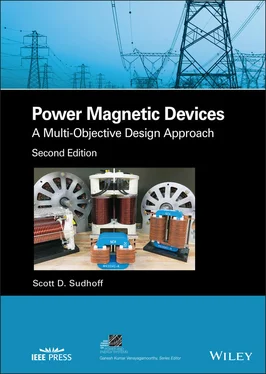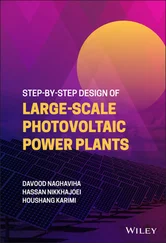Scott D. Sudhoff - Power Magnetic Devices
Здесь есть возможность читать онлайн «Scott D. Sudhoff - Power Magnetic Devices» — ознакомительный отрывок электронной книги совершенно бесплатно, а после прочтения отрывка купить полную версию. В некоторых случаях можно слушать аудио, скачать через торрент в формате fb2 и присутствует краткое содержание. Жанр: unrecognised, на английском языке. Описание произведения, (предисловие) а так же отзывы посетителей доступны на портале библиотеки ЛибКат.
- Название:Power Magnetic Devices
- Автор:
- Жанр:
- Год:неизвестен
- ISBN:нет данных
- Рейтинг книги:4 / 5. Голосов: 1
-
Избранное:Добавить в избранное
- Отзывы:
-
Ваша оценка:
- 80
- 1
- 2
- 3
- 4
- 5
Power Magnetic Devices: краткое содержание, описание и аннотация
Предлагаем к чтению аннотацию, описание, краткое содержание или предисловие (зависит от того, что написал сам автор книги «Power Magnetic Devices»). Если вы не нашли необходимую информацию о книге — напишите в комментариях, мы постараемся отыскать её.
Discover a cutting-edge discussion of the design process for power magnetic devices Power Magnetic Devices: A Multi-Objective Design Approach
Power Magnetic Devices
Power Magnetic Devices — читать онлайн ознакомительный отрывок
Ниже представлен текст книги, разбитый по страницам. Система сохранения места последней прочитанной страницы, позволяет с удобством читать онлайн бесплатно книгу «Power Magnetic Devices», без необходимости каждый раз заново искать на чём Вы остановились. Поставьте закладку, и сможете в любой момент перейти на страницу, на которой закончили чтение.
Интервал:
Закладка:
From a pedagogical point of view, the organization of the text is designed to involve the readers in the design process as rapidly as possible. While it might be more efficient to discuss all the relevant physical effects, and then to discuss the design, such an approach is not always satisfying in that it leaves the reader hungry for a meal a long time before dinner is served. For that reason, the first thirteen chapters of the text generally alternate between discussing a physical effect and considering a design problem in which that effect is considered.
Chapter 1introduces multi‐objective optimization using genetic algorithms. This chapter provides a sufficient background to conduct formal multi‐objective optimization‐based design. Next, Chapter 2provides a background in the magnetic analysis that is used throughout the book. Formal design is introduced in Chapter 3, wherein a simple inductor design is considered, using the material from Chapters 1and 2. In Chapter 4, force and torque production are considered – and in Chapter 5this material is used in simple electromagnet design. Chapter 6concerns magnetic core loss. In this second edition, this chapter has been greatly expanded to include characterization of magnetic materials, as well as to include more information on modeling of magnetic hysteresis. Chapter 7uses the magnetic core loss models in the design of a single‐phase transformer. The alternating pattern of analysis and design continues, with Chapters 8and 9focusing on the rotating machinery.
The text then continues with three primarily analysis chapters to supplement the earlier work, with Chapter 10focusing on thermal analysis (and revisiting some of the earlier design efforts), Chapter 11discussing skin and proximity effect losses, and Chapter 12focusing on parasitic capacitance. The material of these chapters is then tied together in Chapter 13, which considers the design of a dc‐to‐dc converter. Chapters 12and 13are new to the 2nd edition, as are Chapters 14, the design of three‐phase inductors, and Chapter 15, which focuses on the design of common‐mode inductors. The book concludes with Chapter 16, that is also new, which introduces finite element analysis as a method to validate designs.
The amount of material is adequate for two courses. The author recommends that Chapter 1through Chapter 6be covered as a starting point. The remaining chapters could be covered at that discretion of the instructor or the reader.
Chapters 8and 9are based on Chapters 2and 15of Analysis of Electric Machinery and Drive Systems, 3rd Edition, by Paul Krause, Oleg Wasynczuk, Scott Sudhoff, and Steve Pekarek. This work is also published by IEEE/Wiley.
MATLAB source code to support this book is given in S. D. Sudhoff, “MATLAB codes for Power Magnetic Devices: A Multi‐Objective Design Approach, 2nd Edition” [Online]. Available: http://booksupport.wiley.com. This code includes the Genetic Optimization System Engineering Toolbox, a Magnetic Equivalent Circuit Toolbox, a Thermal Equivalent Circuit Toolbox, as well as all the design examples discussed in the book. This should greatly reduce the amount of work needed to either to teach from the book, or to use the principals taught in this text for the reader’s own purposes. Partially annotated slides and a solutions manual are also available.
Throughout this work, scalar variables are normally in italic font (for example) while vectors and matrices are bold non‐italic (for example). Functions of all dimensionalities are denoted by non‐italic non‐bold font (for example). Brackets in equations are associated with iteration number in iterative methods.
The author of this book is deeply indebted to many individuals. First, to my parents, who gave me the time, support, and indulgence for me to pursue my interests. While in high‐school, I was blessed with many excellent teachers. I am particularly indebted to Sister Thomasita Hayes. As an undergraduate, I was also fortunate to have some outstanding instructors – particularly Stanislaw Zak in control and optimization, Fred Mowle who taught me how to code, and Paul Krause, who taught me electric machinery. I spent the beginning part of my career at the University of Missouri – Rolla where I was fortunate to have a number of excellent mentors including Keith Stanek, Max Anderson, and especially Mariesa Crow and Jim Drewniak.
I would thank many current and former students, post docs, and research scientists who directly or indirectly contributed to this book. These include Benjamin Loop, Chunki Kwon, Jim Cale, Aaron Cramer, Brandon Cassimere, Brant Cassimere, Chuck Sullivan, Ricky Chan, Shengyu Wang, Yonggon Lee, Cahya Harianto, Jacob Krizan, Grant Shane, Omar Laldin, Ahmed Taher, Jamal Alsawhali, Harish Suryanarayana, and Jonathan Crider. Jamal Alsawalhi, Grant Shane, Jonathan Crider, Ahmed Taher, Ruiyang Lin, David Loder, Andrew Kasha, Vinicius Cabral Do Nascimento, Akhil Prasad, and Harshita Singh contributed in performing many of the FEA and/or experimental results in the book. I would also especially thank Dionysios Aliprantis for sparking my interest in genetic algorithms.
A variety of U.S. government agencies have contributed to research efforts which contributed to this book, including the Army, Navy, DOE, Sandia National Labs, NREL, ORNL, and NASA. The Office of Naval Research in particular has provided steady support for my entire career which directly and indirectly supported this work, and without which this work would not have been possible. The support of the Grainger Foundation has also been very important to the program at Purdue.
I would thank my colleagues at Purdue. A key attribute of any institution is the people your work with. With this regard, my colleagues at Purdue, namely Oleg Wasynczuk, Steve Pekarek, and Dionysios Aliprantis, are a great group.
Finally, I had some extra help with the second edition. Special thanks to Dr. Harshita Singh, who thoroughly reviewed Chapters 10and 12. Dr Paul Ohodnicki (University of Pittsburg) and Drummond Fudge (Continuous Solutions) provided great feedback on Chapters 13, 14, and 15. Dr. Jamal Alsawalhi (Khalifa University) provided detailed reviews on Chapters 6and 16. Finally, Dr Steve Pekarek (Purdue University) also reviewed Chapter 16. I am greatly indebted to all of these individuals for contributing so much time to the second edition of this book.
About the Companion Site
This book is accompanied by a companion website:
www.wiley.com/go/sudhoff/Powermagneticdevices
The website includes the following materials: Powerpoint slides, Solutions manual, Matlab code
1 Optimization‐Based Design
We will begin our study of power magnetic device design with a general consideration of the design process. A case will be made to approach the design process rather formally by converting the design problem into an optimization problem. Next, single‐objective optimization is discussed, with particular emphasis on optimization using genetic algorithms (GAs). This is followed by a discussion of multi‐objective optimization. Practical aspects of formulating design problems as optimization problems are then considered. The chapter concludes with a design example that focuses on a UI‐core inductor.
1.1 Design Approach
It is appropriate to begin this work by considering the design process. Clearly, there are a myriad of different approaches by which components may be designed. For example, a possible manual design process is illustrated in Figure 1.1. In order to consider this process in a more concrete way, suppose that the component we are designing is an electromagnet and that we wish to design an electromagnet so that a certain set of specifications are met.
Using the design process in Figure 1.1, our first step would be to perform a detailed mathematical analysis of the device. Typically, when we analyze a device, our analysis predicts device performance (mass, loss, force) in terms of the device parameters (geometry, materials) rather than directly addressing the design problem by deriving expressions for what the device parameters should be in terms of the device specifications (allowed loss, required force). Therefore, we must manipulate our detailed analysis into a set of design equations that are used to calculate the design parameters as a function of device specifications. However, going from detailed analysis to design equations invariably requires numerous assumptions and approximations, even beyond the ones found in our original “detailed” analysis. As a result, we check our design, either against our original analysis or using some numerical tool such as a finite element analysis. Based on the results from the numerical analysis, we will revise the design and repeat the numerical analysis until specifications are met, at which point we have arrived at a final design. Of course, we often use a more involved design process; for example, another iteration of the design may be made based on physical prototypes.
Читать дальшеИнтервал:
Закладка:
Похожие книги на «Power Magnetic Devices»
Представляем Вашему вниманию похожие книги на «Power Magnetic Devices» списком для выбора. Мы отобрали схожую по названию и смыслу литературу в надежде предоставить читателям больше вариантов отыскать новые, интересные, ещё непрочитанные произведения.
Обсуждение, отзывы о книге «Power Magnetic Devices» и просто собственные мнения читателей. Оставьте ваши комментарии, напишите, что Вы думаете о произведении, его смысле или главных героях. Укажите что конкретно понравилось, а что нет, и почему Вы так считаете.












